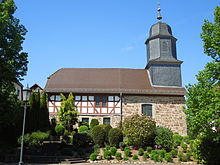Obermöllrich
|
Obermöllrich
City of Fritzlar
Coordinates: 51 ° 7 ′ 41 ″ N , 9 ° 19 ′ 4 ″ E
|
|
|---|---|
| Height : | 188 m above sea level NHN |
| Area : | 4.94 km² |
| Residents : | 630 |
| Population density : | 128 inhabitants / km² |
| Incorporation : | December 31, 1971 |
| Postal code : | 34560 |
| Area code : | 05622 |
Obermöllrich is a district of Fritzlar in northern Hesse . The place is about 3 km east of the city center, on a hill above the north bank of the Eder , between the city center and the district of Cappel and 2 km north of the Wabern district of Zennern . In the north, the district borders on the Werkel district, which also belongs to Fritzlar .
history
In the year 800 the place was first mentioned in a document as "Melriche" in pago Hassorum in Mielere marcha in the so-called Fulda tradition .
Landgrave Heinrich Raspe of Thuringia and his brother Konrad , who later became Grand Master of the Teutonic Order, donated goods to Melderich to the Teutonic Order on November 1st, 1231 . This donation was presumably made in connection with the enforcement of the canonization of her sister-in-law Elisabeth . In 1234, the Premonstratensian Monastery of Ahnaberg (in Kassel ) , founded by Heinrich Raspe II (1140–1148), gave his property in Obermöllrich to the Teutonic Order in hereditary lease . The Order extended his possessions in a Obermöllrich Coming from (Commandery). In 1258 the order founded a bailiwick . In 1305 a commander in Obermöllrich was mentioned for the last time, after which it was a castnaire . The commandery was moved to Fritzlar. A gold panning that the Order had set up on the Eder was not productive enough to be carried out for long.
There were frequent disputes between the order and the neighboring town of Fritzlar, which belongs to Kurmainz, about the boundaries of the district, so that in 1341 a five-person arbitral tribunal was finally appointed to end the dispute.
At that time the order owned about half of the village; the rest and the court were landgrave-Hessian fiefdoms of the von Lynne (or Linne) family from the area of Bottendorf near Frankenberg (Eder ), who also had to deal with the order from time to time opposites. In 1388 both sides agreed to build a new chapel in the village and a fortification around it. In 1395, Landgrave Hermann II of Hesse agreed that Gerlach von Linne pledged his Obermöllrich fiefdom to the order for the rest of his life. In 1448, when the Linne established a castle seat in the churchyard, the dispute between the order and the Linne came to a head so that several family members were exiled. In 1484 the order once again pronounced the ban on the Linne and asked the peasants to drive out their liege lord. Linne was so tired of the matter that, after unsuccessful sales negotiations with the order, he sold his Obermöllrichen property in 1492 to the landgrave, who gave it to Thiemo von Wildungen zu Lehen in 1530 . The Wildungers sold their share of the village in 1590, and after several changes of ownership it came to the Lords of Baumbach - Lenderscheid in 1793 .
In 1585 there were 46 households in the village. The Thirty Years' War had, throughout Hesse, catastrophic consequences: in 1639 there were 14 couples and two widows and four horses and four cows in the village.
The Teutonic Order House built in the 17th century, an important half-timbered building , was demolished in 1954.
The current village church was probably built in 1674, using components from the chapel from 1388. The church tower was added in 1755 and the nave was raised by half-timbering. In 1898 a neo-Gothic extension was carried out.
On December 31, 1971, the previously independent municipality of Obermöllrich was incorporated into the city of Fritzlar.
The village was a prosperous farming village until modern times, with lucrative agriculture in the fertile Eder lowlands and on the loess soils above. Today, the majority of the population works outside of the country and commutes to work in Fritzlar, Wabern and the greater Kassel area .
politics
The current mayor is Michael Orth. (As of October 2018)
literature
- Werner Ide: From Adorf to Zwesten. Local history pocket book for the Fritzlar-Homberg district. A. Bernecker Verlag, Melsungen, 1971
- Rudolf Knappe: Medieval castles in Hessen; 800 castles, castle ruins and fortifications. 3. Edition. Wartberg-Verlag, Gudensberg-Gleichen, 2000, ISBN 3-86134-228-6 , p. 100.
- Heinrich Reimer: Historical local dictionary for Kurhessen. Elwert, Marburg, 1926, pp. 332-333.
- A. Kalkhorst: Ober-Möllrich through the ages. 1968
- Waldemar Küther (Ed.): Historical Ortlexikon Fritzlar-Homberg. Elwert, Marburg, 1980, ISBN 3-7708-0679-4 , pp. 210-212.
Individual evidence
- ↑ a b "Obermöllrich, Schwalm-Eder-Kreis". Historical local dictionary for Hessen. (As of March 26, 2014). In: Landesgeschichtliches Informationssystem Hessen (LAGIS).
- ↑ The location on the website of the city of Fritzlar , accessed in February 2016.
- ^ Federal Statistical Office (ed.): Historical municipality directory for the Federal Republic of Germany. Name, border and key number changes in municipalities, counties and administrative districts from May 27, 1970 to December 31, 1982 . W. Kohlhammer GmbH, Stuttgart and Mainz 1983, ISBN 3-17-003263-1 , p. 392 .
Web links
- Obermöllrich on the website of the city of Fritzlar
- "Obermöllrich, Schwalm-Eder district". Historical local dictionary for Hessen. In: Landesgeschichtliches Informationssystem Hessen (LAGIS).
- Literature about Obermöllrich in the Hessian Bibliography
